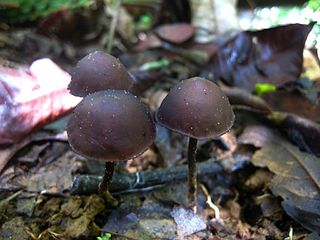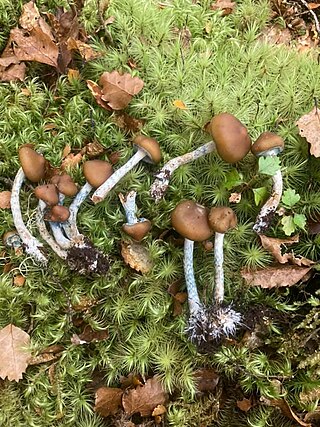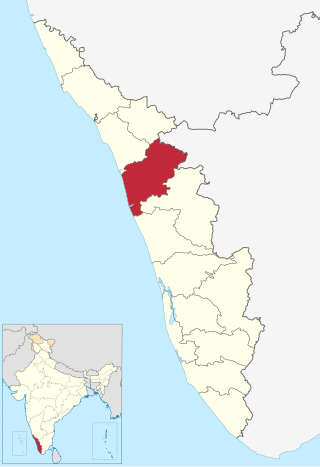
Gymnopilus luteofolius, known as the yellow-gilled gymnopilus, is a large and widely distributed mushroom that grows in dense clusters on dead hardwoods and conifers. It grows in late July to November in the east and in the winter on the west coast of North America. It has a rusty orange spore print and a bitter taste.

Psilocybe guilartensis is a psilocybin mushroom which has psilocybin and psilocin as main active compounds. It is common in Puerto Rico.
Psilocybe naematoliformis, is a species of fungus in the mushroom family Hymenogastraceae. It is a psilocybin mushroom, having psilocybin and psilocin as the main active hallucinogenic compounds.
Gymnopilus cyanopalmicola is a species of mushroom-forming fungus in the family Hymenogastraceae. Found in tropical Mexico, it was described as new to science by Mexican mycologist Laura Guzmán Dávalos in 2006. The flesh of this mushroom turns blue when bruised, hence the specific epithet.

Psilocybe aztecorum is a species of psilocybin mushroom in the family Hymenogastraceae. Known from Arizona, Colorado, central Mexico, India and Costa Rica, the fungus grows on decomposing woody debris and is found in mountainous areas at elevations of 2,000 to 4,000 m, typically in meadows or open, grassy conifer forests. The mushrooms have convex to bell-shaped caps 1.5–2 cm (0.6–0.8 in) in diameter, atop slender cylindrical stems that are up to 7.5 cm (3.0 in) long. The color of the caps changes with variations in hydration, ranging from dark chestnut brown to straw yellow or whitish when dry. The base of the stem is densely covered with conspicuous white rhizomorphs, a characteristic uncommon amongst Psilocybe species.

Psilocybe makarorae is a species of psilocybin mushroom in the family Hymenogastraceae. Officially described as new to science in 1995, it is known only from New Zealand, where it grows on rotting wood and twigs of southern beeches. The fruit body (mushroom) has a brownish cap with lighter coloured margins, measuring up to 3.5 cm (1.4 in) wide. The cap shape is either conical, bell-shaped, or flat depending on the age of the mushroom, and it features a prominent umbo. Although the whitish stem does not form a true ring, it retains remnants of the partial veil that covers and protects the gills of young fruit bodies. P. makarorae mushrooms can be distinguished from the similar North American species Psilocybe caerulipes by microscopic characteristics such as the presence of cystidia on the gill faces (pleurocystidia), and cheilocystidia with more elongated necks. Based on the bluing reaction to injury, P. makarorae is presumed to contain the psychedelic compounds psilocybin and psilocin.

Psilocybe yungensis is a species of psychedelic mushroom in the family Hymenogastraceae. In North America, it is found in northeast, central and southeastern Mexico. In South America, it has been recorded from Bolivia, Colombia, and Ecuador. It is also known from the Caribbean island Martinique, and China. The mushroom grows in clusters or groups on rotting wood. The fruit bodies have conical to bell-shaped reddish- to orangish-brown caps that are up to 2.5 cm (1.0 in) in diameter, set atop slender stems 3 to 5 cm long. The mushrooms stain blue when bruised, indicative of the presence of the compound psilocybin. Psilocybe yungensis is used by Mazatec Indians in the Mexican State of Oaxaca for entheogenic purposes.

Mycena clariviolacea is a mushroom in the family Mycenaceae. First reported as a new species in 2007, it is known only from Kanagawa, Japan, where it fruits on dead fallen twigs in forests dominated by oak and chinquapin trees. Distinctive features of this species are found in its medium-sized, dark violet fruit bodies, with caps up to 25 mm (0.98 in) in diameter and slender stems that are about 30 to 40 mm long. Microscopic characteristics include the amyloid spores, the club-shaped cheilocystidia that are covered with one or more, knob-like, apical protuberances, the absence of pleurocystidia, and the cylindrical, diverticulate caulocystidia.

Mycena fonticola is a species of fungus in the family Mycenaceae. First reported in 2007, it is known only from central Honshu, in Japan, where it grows on dead leaves and twigs in low-elevation forests dominated by oak trees. The fruit body of the fungus has a smooth, violet-brown cap up to 2.5 cm (1.0 in) in diameter, and a slender stem up to 10 cm (3.9 in) long. Distinguishing microscopic characteristics of the mushroom include the relatively large, distinctly amyloid spores, the smooth, spindle-shaped cheilocystidia, the absence of pleurocystidia, the diverticulate hyphae of the cap cuticle, and the absence of clamp connections.

Mycena lanuginosa is a species of mushroom in the family Mycenaceae. First collected in 2000 and reported as a new species in 2007, it is known only from lowland oak-dominated forests in central Honshu in Japan. The small mushroom is characterized by its grooved, grayish-brown to violet-brown cap up to 11 mm (0.43 in) in diameter, and the slender grayish-brown to reddish-brown stem covered with minute, fine, soft hairs. The mushroom produces amyloid spores. Microscopic distinguishing features include the smooth, spindle-shaped cheilocystidia and pleurocystidia and the diverticulate elements in the outer layer of the cap and the stem.

Mycena multiplicata is a species of mushroom in the family Mycenaceae. First described as a new species in 2007, the mushroom is known only from the prefecture of Kanagawa, Japan, where it grows on dead fallen twigs in lowland forests dominated by oak. The mushroom has a whitish cap that reaches up to 13 mm (0.51 in) in diameter atop a slender stem 15 to 20 mm long and 1 to 1.3 mm thick. On the underside of the cap are whitish, distantly spaced gills that are narrowly attached to the stem. Microscopic characteristics of the mushroom include the amyloid spores, the pear-shaped to broadly club-shaped cheilocystidia which are covered with a few to numerous, unevenly spaced, cylindrical protuberances, the lack of pleurocystidia, and the diverticulate hyphae in the outer layer of the cap and stem. The edibility of the mushroom is unknown.

Mycena mustea is a species of mushroom in the family Mycenaceae. First described as a new species in 2007, the fungus is known only from Kanagawa, Japan, where it grows on dead fallen twigs in lowland forests. The mushroom's dull violet to grayish-violet cap, initially covered with a fine whitish powder, becomes smooth as it matures, and eventually reaches a diameter of up to 10 mm (0.39 in). The stem is slender, up to 90 mm (3.5 in) long, and is covered with stiff white hairs at the base. Underneath the cap are distantly spaced pale brownish gills that are narrowly attached to the stem. Microscopic characteristics of the mushroom include the weakly amyloid spores, the club-shaped cheilocystidia featuring one or more short knob-like protuberances, the absence of pleurocystidia, the diverticulate cap cuticle hyphae, and the absence of clamp connections.

Mycena nidificata is a species of fungus in the family Mycenaceae of the Agaricales. First collected in 2000 and reported as a new species in 2007, it is known only from Kanagawa, Japan, where it grows on the floor of oak forests. The dark brown irregularly wrinkled cap measures up to 25 mm (1.0 in) in diameter. The cap is supported by a thin stem up to 50 mm (2.0 in) long, which is covered at the base by a whitish hairlike growth, and attached to white, cord-like rhizomorphs—aggregations of mycelium that resemble plant roots. The underside of the cap features thin, distantly spaced grayish gills that have distinct veins running between them. At a microscopic level, distinguishing characteristics include the inamyloid spores, the club-shaped cheilocystidia with finger-like appendages, the diverticulate cells in the outer layer of cap and stem, and the presence of clamp connections.
Tricholosporum violaceum is a species of fungus in the family Tricholomataceae. Found in Costa Rica, the species was described as new to science in 1996.

Pluteus nevadensis is a species of fungus in the agaric family Pluteaceae. Described as new to science in 2010, the species is known only from subtropical and pine forests in Mexico, where it grows on rotting pine and oak wood. Fruit bodies (mushrooms) have red-orange caps up to 3.8 cm (1.5 in) in diameter with a shape ranging from conic, convex, or flattened, depending on their age. The silky yellow stems are up to 4.5 cm (1.8 in) long. It is similar in appearance to Pluteus aurantiorugosus, with which it shares an orange- or scarlet-colored cap and a yellow stem. P. nevadensis can be distinguished from this and other superficially similar Pluteus species by differences in microscopic characteristics.

Lepiota harithaka is an agaric mushroom of the genus Lepiota in the order Agaricales. It was described as new to science in 2009. Found in Kerala State, India, fruit bodies of the fungus grow on the ground among bamboo roots.

Psilocybe allenii is a species of agaric fungus in the family Hymenogastraceae. Described as new to science in 2012, it is named after John W. Allen, who provided the type collection. It is found in the northwestern North America from British Columbia, Canada to Los Angeles, California, most commonly within 10 miles (16 km) of the Pacific coast.

Tricholoma vernaticum is an agaric fungus of the genus Tricholoma native to the Pacific Northwest region of the United States. The fungus was originally described in 1976 as a species of Armillaria when that genus was more inclusive; it received its current name twenty years later. The stout fruit bodies (mushrooms) have moist white to grayish caps, a membranous ring on the stipe, and an odor resembling cucumbers. Mycorrhizal with conifers, the fungus fruits in the spring or early summer, with its mushrooms appearing on the ground singly or in groups at high elevations, often at the edge of melting snowbanks. The edibility of the mushroom is unknown, but it has a strong unpleasant odor and a mealy taste.

Clitocybe albirhiza, commonly known as the snowmelt clitocybe, is a species of agaric fungus in the family Tricholomataceae. It is found in high-elevation locations in the western United States.
Lepiota cristatanea is a species of agaric fungus in the family Agaricaceae. Described as new to science in 2011, it is found in China. The mushroom is similar to the widespread species Lepiota cristata but can be distinguished by its smaller spores.











